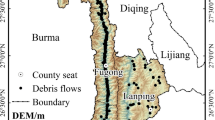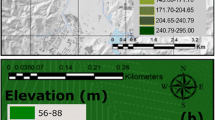Abstract
This paper presents a neural network (NN) based model to assess the regional hazard degree of debris flows in Lake Qionghai Watershed, China. The NN model was used as an alternative for the more conventional linear model MFCAM (multi-factor composite assessment model) in order to effectively handle the nonlinearity and uncertainty inherent in the debris flow hazard analysis. The NN model was configured using a three layer structure with eight input nodes and one output node, and the number of nodes in the hidden layer was determined through an iterative process of varying the number of nodes in the hidden layer until an optimal performance was achieved. The eight variables used to represent the eight input nodes include density of debris flow gully, degree of weathering of rocks, active fault density, area percentage of slope land greater than 25° of the total land (APL25), frequency of flooding hazards, average covariance of monthly precipitation by 10 years (ACMP10), average days with rainfall >25 mm by 10 years (25D10Y), and percentage of cultivated land with slope land greater than 25° of the total cultivated land (PCL25). The output node represents the hazard-degree ranks (HDR). The model was trained with the 35 sets of data obtained from previous researches reported in literatures, and an explicit uncertainty analysis was undertaken to address the uncertainty in model training and prediction. Before the NN model is extrapolated to Lake Qionghai Watershed, a validation case, different from the above data, is conducted. In addition, the performances of the NN model and the MFCAM were compared. The NN model predicted that the HDRs of the five sub-watersheds in the Lake Qionghai Watershed were IV, IV, III, III, and IV–V, indicating that the study area covers normal hazard and severe hazard areas. Based on the NN model results, debris flow management and economic development strategies in the study are proposed for each sub-watershed.




Similar content being viewed by others
References
Alistair KW, Howard KH, Stephen AK (2002) Doing statistics with SPSS. SAGE Publication, London, 238 pp
Beale R, Jackson T (1990) Neural computing: an introduction. Institute of Physics Publishing, Bristol, pp 39–61
Bisson M, Cosimi G, Favalli M, Leoni FM, Mazzarini F, Pareschi MT, Santacroce R, Sgro S, Sulpizio R, Zanchetta G (2002) GIS database for the assessment of debris flow hazard in two areas of the Campania region (southern Italy). Geophys Space Phys 25(4):433–447
Bouguettaya A, Le VQ (1998) Data clustering analysis in a multidimensional space. Inf Sci 112(1–4):267–295
Costa JE (1984) Physical geomorphology of debris flows. In: Costa JE, Fleischer PJ (eds) Developments and applications of geomorphology. Springer, Berlin Heidelberg New York, pp 268–317
Deyle RE, French SP, Olshansky RB, Paterson RG (1998) Hazard assessment: the factual basis for planning and mitigation. In: Burby RJ (ed) Cooperating with nature: confronting natural hazards with land-use planning for sustainable communities. Joseph Henry Press, Washington, DC, pp 119–166
Ferhat BA (2001) Application of an artificial neural network model to a Na–K geothermometer. J Volcanol Geotherm Res 121(1–4):75–81
Fu L (1994) Neural networks in computer intelligence. McGraw-Hill, Singapore, 460 pp
He YP, Xie H, Cui P, Wei FQ, Zhong DL, Gardner JS (2003) GIS-based hazard mapping and zonation of debris flows in Xiaojiang Basin, southwestern China. Environ Geol 45:286–293
Irish LB, Barrett ME, Malina JF, Charbeneau RJ (1998) Use of regression models for analyzing highway storm-water loads. J Environ Eng ASCE 124(10):987–993
Jan CD, Shen HW (1997) Review dynamic modeling of debris flows. In: Armanini A, Michiue M (eds) Recent developments on debris flows. Springer, Berlin Heidelberg New York, pp 93–116
Kartal S, Ozer U (1998) Determination and parameterization of some air pollutants as a function of meteorological parameters in Kayseri, Turkey. J Air Waste Manage Assoc 48(9):853–859
Lee IM, Lee JH (1996) Prediction of pile bearing capacity using artificial neural networks. Comput Geotech 18(3):189–200
Lee S, Ryu JH, Lee MJ, Won JS (2003) Use of an artificial neural network for analysis of the susceptibility to landslides at Boun, Korea. Environ Geol 44(7):820–833
Lin PS, Lin JY, Hung JC, Yang MD (2000) Risk assessment of potential debris flows using GIS. In: Proceedings of the 2nd international conference on debris-flow. Balkema, Amsterdam, pp 431–440
Lin PS, Lin JY, Hung JC, Yang MD (2002) Assessing debris-flow hazard in a watershed in Taiwan. Eng Geol 66:295–313
Liu XL (2002) Advance in research on assessment for degree of regional debris flow hazard (in Chinese). Chin J Geol Hazard Control 13(4):1–9
Liu Y, Guo HC (2004) The approach for predicting the concentration of air pollutants in cities (in Chinese). J Safe Environ 4(4):60–62
Liu XL, Lei J (2003) A method for assessing regional debris flow risk: an application in Zhaotong of Yunnan province (SW China). Geomorphology 52:181–191
Liu XL, Tang C (1995) Assessment of debris flow risk (in Chinese). Science Press, Beijing, pp 60–81
Liu XL, Zhang D (2004) Comparison of two empirical models for gully-specific debris flow hazard assessment in Xiaojiang Valley of southwestern China. Nat Hazards 31:157–175
Liu XL, Zhong QY, Leslie GT, Lee CF (2002) Empirical assessment of debris flow risk on a regional scale in Yunnan Province, southwestern China. Environ Manage 30(2):249–264
Liu Y, Guo HC, Wang LJ (2005) Scenario analysis and its application in environmental planning (in Chinese). Res Environ Sci 18(3):82–87
Luger GF (2002) Artificial intelligence: structures and strategies for complex problem solving. Addison-Wesley, New York, pp 431–438
Marquardt D (1963) An algorithm for least-squares estimation of nonlinear parameters. SIAM J Appl Math 11:431–441
Neaupane K, Achet S (2003) Some applications of a backpropagation neural network in geo-engineering. Environ Geol 45(4):567–575
Philippe DW (1997) Neural network models: theory and projects. Springer, Berlin Heidelberg New York, 174 pp
Rickenmann D (1999) Empirical relationships for debris flows. Nat Hazards 19:47–77
Rickenmann D, Beurteilung von M (1995) Assessment of debris flows. Schweiz Ingenieur Architekt 48:1104–1108
Robert J Schalkoff (1997) Artificial neural networks. McGraw-Hill, New York, pp 194–196
Rumelhart DE, McClelland JL, PDP Research Group (1986) Parallel distributed processing: explorations in the microstructure of cognition. MIT Press, Cambridge
Seginer I (1997) Some artificial neural network applications to greenhouse environmental control. Comput Electron Agric 18(2–3):167–186
Tan WP (1994) Forecast of rainstorm debris flow: take western Panzhihua area as an example (in Chinese). Sichuan Science and Technology Press, Chengdu, pp 51–98
Wen X, Zhou L, Wang D (2000) Application of MATLAB in neural network (in Chinese). Science Press, Beijing, pp 220–225
Xie Y (2002) Restoration of crude vegetation in China (in Chinese). China Forestry Publishing House, Beijing, pp 30–36
Yuan W (1999) Statistics (in Chinese). Economic Science Press, Beijing, pp 342–352
Zhong DL, Xie H, Wang SG (2004) Debris flow in the Beijing Mountain (in Chinese). Commercial Press, Beijing pp 175–199
Zou R, Lung WS, Guo HC (2002) Neural network embedded Monte Carlo approach for water quality modeling under input information uncertainty. J Comput Civil Eng 16(2):135–142
Acknowledgements
This paper was supported by the “National Basic Research (973) Program” Project (No. 2005CB724205) of the Ministry of Science and Technology of China.
Author information
Authors and Affiliations
Corresponding author
Rights and permissions
About this article
Cite this article
Liu, Y., Guo, H.C., Zou, R. et al. Neural network modeling for regional hazard assessment of debris flow in Lake Qionghai Watershed, China. Environ Geol 49, 968–976 (2006). https://doi.org/10.1007/s00254-005-0135-7
Received:
Accepted:
Published:
Issue Date:
DOI: https://doi.org/10.1007/s00254-005-0135-7




